Natural Sea Salt / The Story
> Areas of Business > Primary Industry > Natural Sea Salt / The Story
The quality of the tidal flats is what decides the quality of the Natural Sea Salt. Top-quality tidal flat Natural Sea Salt produced in the Ecological Grand Slam represents only 0.1% of the entire salts in the world
What makes the Natural Sea Salt product in the Taepyung Salt Farm the world’s premium quality?
Premium Natural Sea Salt produced in the ecologically clean environment
Natural Sea Salt is an indispensable and precious gift among the resources that the nature bestowed upon the humans. Natural Sea Salt uses seawater as the main ingredient. The salt concentration in seawater is 3%, and the salt concentration inside a pregnant mother’s stomach is equally 3%. Water that accounts for 70% of the human body can sustain life only when it maintains the same condition of the seawater. It may thus be natural that the seawater, the source of life, is reborn as salt, which is an essential ingredient for the mankind. The Natural Sea Salt containing such natural vitality is influenced greatly by the natural environment throughout the production process. The Natural Sea Salt of the Taepyung Salt Farm is produced in Jeungdo Islad, the first Slow City to be designated in the Asian region for its pure natural environment. In addition to the designation as Slow City, Jeungdo Island in Shinan of Jeonnam boasts of the blessed ecologically clean environment with the designation as the UNESCO Biosphere Reserve and the Ramsar wetlands. The fresh and clean seawater in the Aegean Sea full of minerals, tidal flats in Taepyung Sea Farm containing the ecological environment designated as Ramsar wetlands as it is, warm sunshine that evaporates the uncontaminated air to produce high quality Natural Sea Salt in Korea are what completes the clean and healthy Natural Sea Salt in the Taepyung Sea Farm.
Premium Natural Sea Salt made by the salt craftsmen of 60 years of tradition
In 1953, Taepyung Salt Farm was created at the center of the uncontaminated Jeungdo Island by blocking the front Jeungdo and rear Jeungdo area as the refugee settlement policy at the end of the Korean War. 60 years had passed since then, and the salt craftsmen who have been with the Taepyung Salt Farm always start the day off with a prayer for the production of high quality Natural Sea Salt, bringing fresh seawater into the farm before the dawn. Interestingly, the quality and the production amount may vary even from the same environment and the same salt farm depending on who produces it. Korean Natural Sea Salt is produced in the traditional method dependent on the natural environment, and the Mother Nature is aware of this to decide the taste, crystal size, and production amount of the salt according to the salt craftsmen’s care and effort. The salt craftsmen at Taepyung Salt Farm have been and are working hard even at this moment to continue the tradition of the Natural Sea Salt production technology of 60 years and to produce the fine Natural Sea Salt of Korea that accounts for 0.1% of the entire salt in the world.
Excellence in Natural Sea Salt in Jeonnam Area
Natural Sea Salt from the Jeonnam area is richer in minerals in comparison with the French salt, and far superior to the the salt of French Guérande in light of magnesium content.
Source: Jeollanam-do Institute of Health and Environment, 2007
| Mineral | Made in Jeonnam | Made in Guérande | Made in China | Vietnam, Japan | Australia, Mexico |
|---|---|---|---|---|---|
| Calcium (Ca) | 1,429 | 1,493 | 920 | 761 | 349 |
| Potassium (K) | 3,067 | 1,073 | 1,042 | 837 | 182 |
| Magnesium (Mg) | 9,797 | 3,975 | 4,490 | 3,106 | 100 |
Natural Sea Salt Production Process
The salt farms are composed largely of reservoir, evaporation field, and crystallization field. The reservoir is a space for storing seawater while the evaporation field is where the salinity is raised through sunlight and wind. It consists of nanchi (1st evaporation) and nute (second evaporation). Crystallization field serves to make the brine in the evaporation site into salt crystals. It takes about 20 to 25 days to produce salt throughout all these processes.
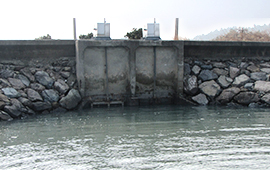
01. Seawater stocking
Let the seawater (salinity of about 1-2 degrees) into the reservoir through the floodgate.
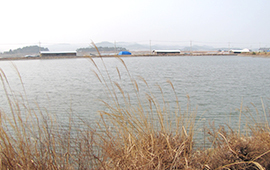
02. Reservoir
Then the seawater is kept in the reservoir to secure the salt ingredients.
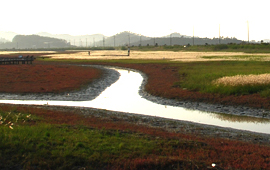
03. Waterway
To make salt, the seawater stored in the reservoir is sent to the 1st evaporation field (nanchi) through the waterway.
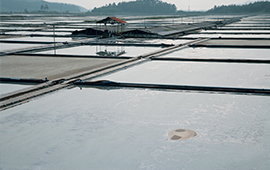
04. Evaporation field
The 1st evaporation field (nanchi) where the seawater is concentrated may vary from the climate, but, it usually spends a week to evaporate to make salt water of about 6 to 8-degree salinity (saline water) and moves it to the 2nd evaporation field (nute).
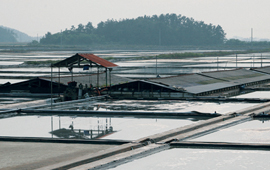
05. Brine storage
In order to prepare for rainfall or wintering, the brine is kept in the brine warehouse which stores the saturated brine in the evaporation field and the crystallization field. And then, when the concentration of the brine reaches 23 to 25 degrees, the stored water is sent to the crystallization field.
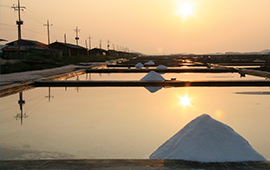
06. Crystallization field
Crystallization field is where salt is separated by further concentrating the saturated brine concentrated in the evaporation field. The brine that is supplied to the crystallization field around 6:00 a.m. can be collected as salt by about 4 to 6 p.m. It varies from the weather conditions, but it usually takes about 1 to 4 days to collect the salt.
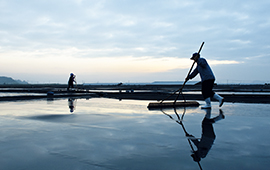
07. Salt collection
The salt collected from the crystallization field is gathered in one place by using the chisel.
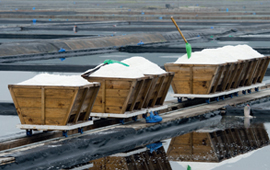
08. Transport to warehouse
The water residue in the collected salt is drained to some extent and then transferred to the salt warehouse using a handcart or a wheelbarrow.
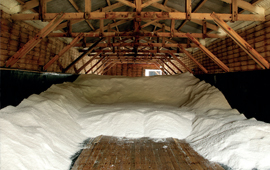
09. Storage
The salt that is moved to the warehouse is kept for a certain period of time before sale after sea water is drained.
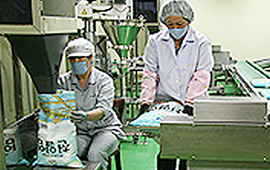
10. Packing & Transport
The finished Natural Sea Salt is packed by batch unit, and the delicious and healthy Natural Sea Salt made from the land, sunlight and wind of Korea is transported safely to the place of sale.
The production of Natural Sea Salts is mostly dependent on the nature’s way, The production of Natural Sea Salts is mostly dependent on the nature’s way, and that’s why it’s called the nature-given treasures. The production stage of the Natural Sea Salt is divided largely into reservoir, evaporation field and crystallization field. Seawater is locked inside the tidal reservoir, and then, the seawater in the reservoir is being transferred to the evaporation field to be evaporated. The evaporated seawater is transferred to the crystallization field to be saturated. When it becomes crystallized, the salt collection begins to produce the Natural Sea Salt. The produced Natural Sea Salt can be used right away, but those stored in the salt warehouse of which bittern can be drained for a couple of years are considered to be superior in quality. Admittedly, there has been consumers’ concern over the Natural Sea Salt for residual heavy metals or other contaminants, but in Korea, our Natural Sea Salt can’t be cleaner because the salt farm in set on the tidal flat with strong purification ability. There has been a set of consistent studies conducted on the Natural Sea Salt and, as a result of these research activities, it has been identified that the Korean Natural Sea Salt is free from harmful substances but richly contains beneficial substances such as minerals.




